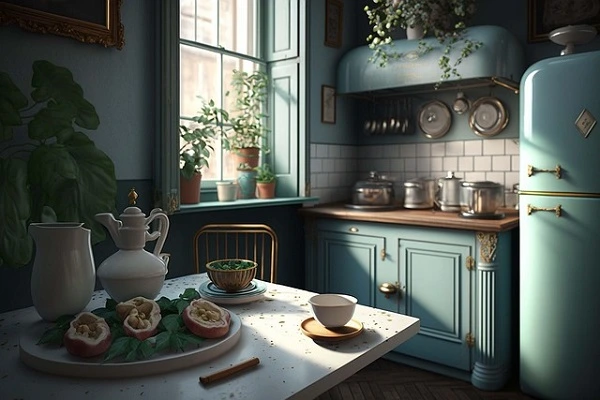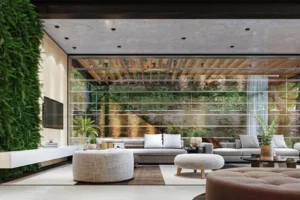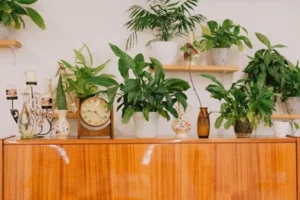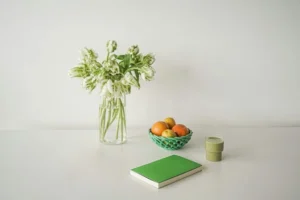Let’s be honest—most of us have that weird, narrow gap beside the fridge. It’s not quite big enough for storage, and not quite small enough to ignore. It usually becomes a catchall for dust, plastic bags, or maybe a forgotten broom.
But what if that dead space could actually grow you food?
In small apartments, every inch counts. That’s why crafty, multi-level grow setups designed for slim corners are catching on with DIYers. They offer structure, efficiency, and a surprising touch of style—all without dominating your kitchen.
This guide is all about building something functional in the last place you thought to look. So grab a tape measure and let’s reimagine that skinny slice of your kitchen as a living, edible display.
Why Beside-the-Fridge Spaces Are a Hidden Gem
We often overlook the narrow strip between the fridge and the wall. It’s awkward, tight, and usually becomes home to lost crumbs or a folding step stool. But in a small apartment, even the least glamorous corners can hold potential.
This slim area is actually a prime spot for growing.
First, it’s usually located near a water source—hello, kitchen sink—making maintenance easy. You’re less likely to forget to top off a reservoir when it’s just steps away from the faucet.
Second, the airflow here tends to be consistent. Fridges generate a small amount of ambient heat and airflow, which, in small doses, can benefit certain plants. It’s not a greenhouse, but it’s not dead air either.
Third, many kitchens already have decent lighting nearby—windows, under-cabinet LEDs, or even the fridge light can supplement your grow rig. It may not be full-spectrum, but it’s a head start.
And finally, there’s psychology. That neglected gap isn’t doing much for your mood. Add some greenery, and suddenly your kitchen feels more alive, more cared for—even if the space is barely wider than a shoebox.
A few more reasons this spot is golden:
- It’s out of the way but highly visible.
- It’s vertical-ready by default.
- It keeps fresh ingredients within reach while cooking.
So instead of blocking that space with a broom or hiding it behind clutter, think of it as a slim blank canvas. The perfect place for your next multi-level build.
Planning the Build – Measurements, Layouts, and Fridge Dynamics
Before grabbing materials, the first step is to size up your space. Measure the width, depth, and height of the gap beside your fridge. Even a few inches can make or break your build.
Don’t forget to check for vents or power cords on the fridge’s sides or back. These can limit where shelves or attachments go without blocking airflow or creating hazards.
Next, think about how much vertical space you have. Some fridges sit lower, leaving more room above, while others nearly touch the ceiling. Your setup should fit comfortably without crowding the fridge door or blocking access.
Now, consider layout styles. Here are a few ideas:
- Single spine: A narrow, tall rack that hugs the wall or fridge side.
- Angled shelves: Shelves tilted slightly forward for better light and drainage.
- Column cascade: Multiple small shelves staggered vertically, creating a cascading effect.
- Zig-zag stacks: Shelves offset on alternating sides to maximize space.
Each layout has pros and cons, depending on space and your plant choices.
Finally, factor in fridge dynamics. The fridge gives off a small amount of heat; keep plants that like warmth closer, but avoid direct heat that could dry them out. Also, allow enough clearance for the fridge door to open fully without hitting your build.
Planning well now means fewer headaches later and a more functional, long-lasting setup. Measure twice, build once!
Structural Materials That Work in Tight Kitchen Corners
Choosing the right materials is key for a sturdy, long-lasting build beside your fridge. You want something lightweight but strong enough to hold your plants and water without warping or tipping.
PVC pipes are a favorite among DIYers. They’re inexpensive, moisture-resistant, and easy to cut or connect. Plus, they won’t rust in the humid kitchen environment. You can create frames, shelves, or even vertical columns with them.
Wood is another solid option, especially lightweight varieties like pine or cedar. Just be sure to seal or paint it to protect against moisture. Wood adds warmth and style, blending nicely with kitchen decor.
Metal frames, like aluminum or repurposed steel racks, offer great durability. They’re sleek and industrial but can get heavy or cold. Consider powder-coated finishes to prevent rust.
If you want to keep things simple, look around for pre-made racks or drying racks that can be repurposed. These often fit tight spaces and save construction time.
Magnetic components are worth exploring too. Magnetic shelves or hooks can attach directly to the fridge’s side, perfect for small pots or tools.
Here’s a quick material checklist to consider:
- Moisture resistance
- Weight capacity
- Ease of assembly
- Visual appeal
- Kitchen safety (no sharp edges or toxic finishes)
Choosing the right materials upfront makes your setup safer, more functional, and more enjoyable. Plus, it gives your green corner a polished, intentional look.
Layered Growing Options That Make the Most of Every Inch
When working with a narrow space beside your fridge, layering your plants smartly is a game-changer. You want to stack greenery without creating a jungle that blocks light or airflow.
Start with plants that grow well in compact containers and don’t spread too wildly. Microgreens, herbs like basil and mint, and small lettuces are perfect.
Think about how each layer gets light. Place fast-growing or light-loving plants near the top, where they can soak up any available glow. Shade-tolerant varieties go below.
You can mix trailing plants, like creeping thyme or small ivy, along the sides of your setup. These add visual interest without eating up floor space.
Consider these layering tips:
- Use shallow trays on upper shelves for seedlings or microgreens.
- Reserve mid-level shelves for medium-sized pots with herbs or leafy greens.
- Keep heavier or water-loving plants near the bottom where reservoirs or drip trays can support them.
Rotating trays or shelves can help ensure all plants get even light and airflow. This also makes maintenance easier.
Companion planting works here too. Pair herbs and veggies that support each other’s growth, like basil with tomatoes or lettuce with radishes.
By designing your layers thoughtfully, you’ll create a vibrant, productive grow space that fits seamlessly beside your fridge. It’s all about maximizing light, space, and plant health—without the clutter.
Watering and Light Strategies Without Making a Mess
One of the biggest challenges with a slim grow setup beside the fridge is keeping things tidy. You want healthy plants, not water spills or awkward light setups.
For watering, passive systems like wick setups work wonders. They slowly draw water from a reservoir to the plants without overwatering. It’s low maintenance and reduces mess.
Mini drip tubing is another option. You can set it up with a small pump or even gravity-fed bottles. Just make sure you have trays or catch basins underneath to catch any drips.
Self-contained reservoirs are perfect for these compact rigs. They keep water contained and reduce spills. Plus, they’re easy to refill right by the sink.
Lighting is equally important. Slim LED strips are your best friends here. They fit into tight spaces and provide enough light without heating up the area.
Magnetic grow lights are clever too. You can attach them directly to the fridge or frame, allowing for easy repositioning.
To make life easier, consider timer-based automation. Set your lights and watering schedules so plants get consistent care even when you’re busy.
Keep these tips in mind:
- Use water trays to prevent leaks
- Opt for cool LED lighting to avoid heat buildup
- Position lights to avoid shadowing
- Use timers for consistent care
With these watering and lighting tricks, your crafty setup stays neat and thriving without stealing your time or patience.
Aesthetic & Functional Finishing Touches
Once your multi-level build is up and running, it’s time to make it look as good as it grows. A well-finished setup not only boosts your kitchen’s vibe but also makes maintenance easier.
Start by thinking about how your rig fits with the existing decor. Wood panels add warmth, while metal frames offer a sleek, modern look. You can even paint or stain materials to match your kitchen’s style.
Labels are a simple way to stay organized. Chalkboard tags or small wooden markers help you keep track of what’s growing where, especially if you’re juggling herbs and veggies.
Adding hooks or magnetic clips is another smart move. They hold small tools, watering cans, or seed packets, keeping everything within easy reach.
Try these ideas for function and flair:
- Copper rails or piping for a trendy industrial touch
- Magnetic seed pod holders stuck to the fridge side
- Small baskets or trays for harvesting and storage
- Clip-on grow lights or fans for added plant care
Don’t forget to hide cables and tubing neatly along the frame or behind panels. It keeps your setup clean and safe, and makes the whole thing look more polished.
Finishing touches show your personality and make your grow corner something you’re proud to share—whether with friends or just yourself. A functional, beautiful space invites you to keep experimenting and growing.
Building Beauty Where You’d Least Expect It
That narrow space beside your fridge doesn’t have to be forgotten or cluttered. With a crafty multi-level setup, it becomes a vibrant, productive corner filled with fresh greens.
This project shows how smart design and careful planning transform tiny gaps into thriving grow spaces.
Remember, this is about systems that work efficiently in tight spots, not quick beginner hacks. When done right, these builds add function and style without crowding your kitchen.
So, grab your tools and rethink that slim corner—it’s a hidden gem just waiting for your green touch.
And if you try it out, share your setup! There’s always more to learn and improve in these creative micro-gardens.




